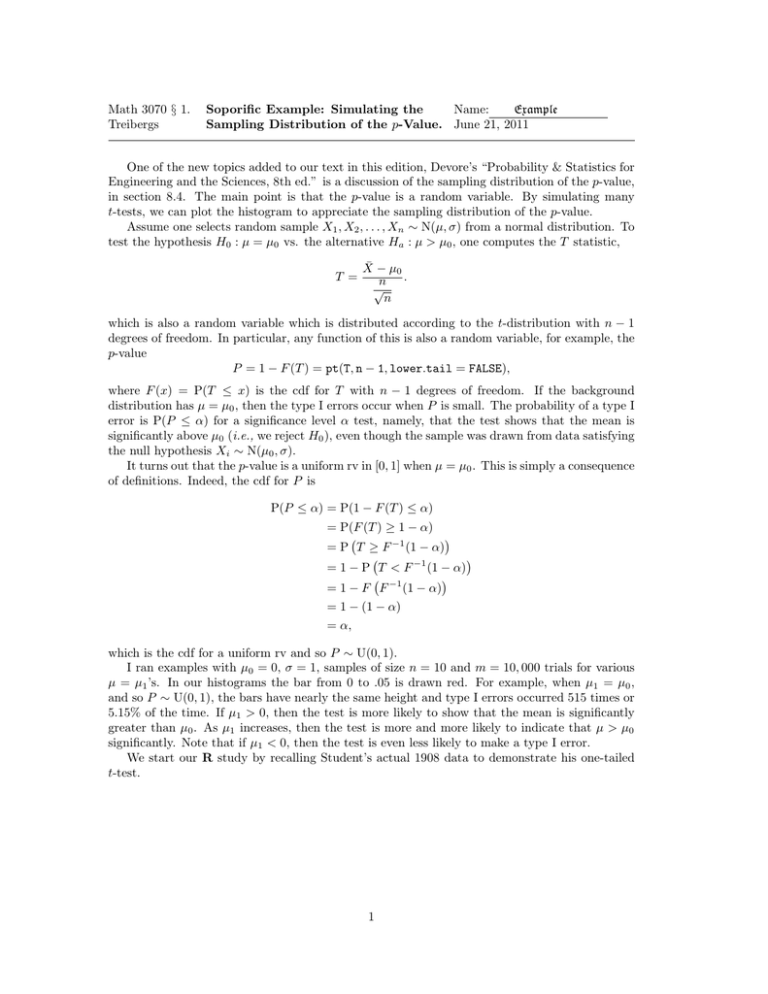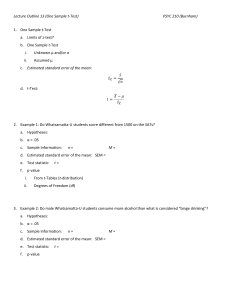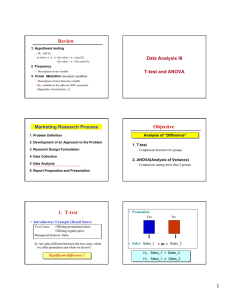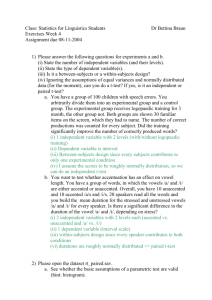Math 3070 § 1. Soporific Example: Simulating the Name: Example
advertisement

Math 3070 § 1.
Treibergs
Soporific Example: Simulating the
Name:
Example
Sampling Distribution of the p-Value. June 21, 2011
One of the new topics added to our text in this edition, Devore’s “Probability & Statistics for
Engineering and the Sciences, 8th ed.” is a discussion of the sampling distribution of the p-value,
in section 8.4. The main point is that the p-value is a random variable. By simulating many
t-tests, we can plot the histogram to appreciate the sampling distribution of the p-value.
Assume one selects random sample X1 , X2 , . . . , Xn ∼ N(µ, σ) from a normal distribution. To
test the hypothesis H0 : µ = µ0 vs. the alternative Ha : µ > µ0 , one computes the T statistic,
T =
X̄ − µ0
n .
√
n
which is also a random variable which is distributed according to the t-distribution with n − 1
degrees of freedom. In particular, any function of this is also a random variable, for example, the
p-value
P = 1 − F (T ) = pt(T, n − 1, lower.tail = FALSE),
where F (x) = P(T ≤ x) is the cdf for T with n − 1 degrees of freedom. If the background
distribution has µ = µ0 , then the type I errors occur when P is small. The probability of a type I
error is P(P ≤ α) for a significance level α test, namely, that the test shows that the mean is
significantly above µ0 (i.e., we reject H0 ), even though the sample was drawn from data satisfying
the null hypothesis Xi ∼ N(µ0 , σ).
It turns out that the p-value is a uniform rv in [0, 1] when µ = µ0 . This is simply a consequence
of definitions. Indeed, the cdf for P is
P(P ≤ α) = P(1 − F (T ) ≤ α)
= P(F (T ) ≥ 1 − α)
= P T ≥ F −1 (1 − α)
= 1 − P T < F −1 (1 − α)
= 1 − F F −1 (1 − α)
= 1 − (1 − α)
= α,
which is the cdf for a uniform rv and so P ∼ U(0, 1).
I ran examples with µ0 = 0, σ = 1, samples of size n = 10 and m = 10, 000 trials for various
µ = µ1 ’s. In our histograms the bar from 0 to .05 is drawn red. For example, when µ1 = µ0 ,
and so P ∼ U(0, 1), the bars have nearly the same height and type I errors occurred 515 times or
5.15% of the time. If µ1 > 0, then the test is more likely to show that the mean is significantly
greater than µ0 . As µ1 increases, then the test is more and more likely to indicate that µ > µ0
significantly. Note that if µ1 < 0, then the test is even less likely to make a type I error.
We start our R study by recalling Student’s actual 1908 data to demonstrate his one-tailed
t-test.
1
R Session:
R version 2.10.1 (2009-12-14)
Copyright (C) 2009 The R Foundation for Statistical Computing
ISBN 3-900051-07-0
R is free software and comes with ABSOLUTELY NO WARRANTY.
You are welcome to redistribute it under certain conditions.
Type ’license()’ or ’licence()’ for distribution details.
Natural language support but running in an English locale
R is a collaborative project with many contributors.
Type ’contributors()’ for more information and
’citation()’ on how to cite R or R packages in publications.
Type ’demo()’ for some demos, ’help()’ for on-line help, or
’help.start()’ for an HTML browser interface to help.
Type ’q()’ to quit R.
[R.app GUI 1.31 (5538) powerpc-apple-darwin8.11.1]
[Workspace restored from /Users/andrejstreibergs/.RData]
> ############# STUDENT’S ONE-DAMPLE T-TEST DATA ##########################
> # From M.G.Bulmer, "Principles of Statistics," Dover, 1979.
> # Student’s 1908 Data:
> # Additional hrs sleep gained after administering Hyoscene
> # to ten patients
> #
> x <- scan()
1: 1.9 .8 1.1 .1 -.1 4.4 5.5 1.6 4.6 3.4
11:
Read 10 items
> x
[1] 1.9 0.8 1.1 0.1 -0.1 4.4 5.5 1.6 4.6 3.4
> t.test(x,alternative="greater")
One Sample t-test
data: x
t = 3.6799, df = 9, p-value = 0.002538
alternative hypothesis: true mean is greater than 0
95 percent confidence interval:
1.169334
Inf
sample estimates:
mean of x
2.33
> # Strong evidence that mu>0: Hyocene is soporific
2
> ################### ANALYZE THE DATA BY HAND #############################
> xbar <- mean(x); xbar
[1] 2.33
> s <- sd(x); s
[1] 2.002249
> n <- length(x); n
[1] 10
> t <- xbar/(s/sqrt(n)); t
[1] 3.679916
> # crit value for upper tailed test
> alpha <- .05
> qalpha <- qt(alpha, df = n-1, lower.tail = FALSE); qalpha
[1] 1.833113
> # T exceeds this so at 1-alpha conf., mu signif. greater than 0
> PV <- pt(t, n-1, lower.tail = FALSE); PV
[1] 0.002538066
> # same numbers as from canned test.
>
>
>
>
>
>
>
>
>
>
>
>
>
>
>
>
>
>
>
>
>
>
>
+
>
>
>
>
>
###################### SAMPLING DISTRIBUTION OF P-VALUE ###################
# simulate p-values.
# mu1 = mean of normal variable, 1 = sd of normal variable.
# m = number of trials
m <- 10000
# n = sample size
n <- 10
# to make sure these computations are done outside the loop.
c <- sqrt(n)
nu <- n-1
# Vector of nice colors.
cl <- c(2,rep(rainbow(12,alpha=.4)[6],19))
xl <- "p - Value"
#
#
#
#
#
The sapply(v,f) does the function "f" to each element of vector "v"
In our case, f generates a p-value from a random sample every time
it’s called.
In a vector oriented language, vectorwise computations replace loops
and do it faster.
mu1 <- 0
# Save the title.
mn <- paste("Histogram of t-Test p-Values, Sample from N(",mu1,",1),
\n Samp.Size=", n,", No.Trials=", m)
# Each call to pv gives p-value for a simulated upper-tail t-test
# for size n. Z is a random N(mu1,sigma) sample of size n
pv <- function(j){Z<- rnorm(n,mu1,1);pt(c*mean(Z)/sd(Z),nu,lower.tail=F)}
hist(sapply(1:m,pv),breaks=20,col=cl,labels=T,main=mn,xlab=xl)
# M3074RVpValue1.pdf
3
>
>
+
>
>
>
>
>
>
>
+
>
>
>
>
>
>
>
+
>
>
>
>
>
>
>
+
>
>
>
>
>
>
>
+
>
>
mu1 <- 0.1
mn <- paste("Histogram of t-Test p-Values, Sample from N(",mu1,",1),
\n Samp.Size=", n, ", No.Trials=", m)
pv <- function(j){Z<- rnorm(n,mu1,1);pt(c*mean(Z)/sd(Z),nu,lower.tail=F)}
hist(sapply(1:m,pv),breaks=20,col=cl,labels=T,main=mn,xlab=xl)
# M3074RVpValue2.pdf
mu1 <- 0.2
mn <- paste("Histogram of t-Test p-Values, Sample from N(",mu1,",1),
\n Samp.Size=", n, ", No.Trials=", m)
pv <- function(j){Z<- rnorm(n,mu1,1);pt(c*mean(Z)/sd(Z),nu,lower.tail=F)}
hist(sapply(1:m,pv),breaks=20,col=cl,labels=T,main=mn,xlab=xl)
# M3074RVpValue3.pdf
mu1 <- 0.5
mn <- paste("Histogram of t-Test p-Values, Sample from N(",mu1,",1),
\n Samp.Size=", n, ", No.Trials=", m)
pv <- function(j){Z<- rnorm(n,mu1,1);pt(c*mean(Z)/sd(Z),nu,lower.tail=F)}
hist(sapply(1:m,pv),breaks=20,col=cl,labels=T,main=mn,xlab=xl)
# M3074RVpValue4.pdf
mu1 <- 1
mn <- paste("Histogram of t-Test p-Values, Sample from N(",mu1,",1),
\n Samp.Size=", n,", No.Trials=",m)
pv <- function(j){Z<- rnorm(n,mu1,1);pt(c*mean(Z)/sd(Z),nu,lower.tail=F)}
hist(sapply(1:m,pv),breaks=20,col=cl,labels=T,main=mn,xlab=xl)
# M3074RVpValue5.pdf
mu1 <- -.5
mn <- paste("Histogram of t-Test p-Values, Sample from N(",mu1,",1),
\n Samp.Size=", n, ", No.Trials=", m)
hist(sapply(1:m,pv),breaks=20,col=cl,labels=T,main=mn,xlab=xl)
# M3074RVpValue6.pdf
4
Histogram of t-Test p-Values, Sample from N( 0 ,1),
Samp.Size= 10 , No.Trials= 10000
537
515512
515
510
508
501510
500
498
489
489
484
477
473469
492
485
472
300
200
100
0
Frequency
400
500
564
0.0
0.2
0.4
0.6
p - Value
5
0.8
1.0
Histogram of t-Test p-Values, Sample from N( 0.1 ,1),
Samp.Size= 10 , No.Trials= 10000
800
872
756
584581569
561
534
484474469
443
400
391382
360
343330
295
200
241
0
Frequency
600
678
653
0.0
0.2
0.4
0.6
p - Value
6
0.8
1.0
1436
1200
1400
Histogram of t-Test p-Values, Sample from N( 0.2 ,1),
Samp.Size= 10 , No.Trials= 10000
800
854
792
600
642
583608
200
400
507
458439
409
360
329
294296
252
197189
147130
0
Frequency
1000
1078
0.0
0.2
0.4
0.6
p - Value
7
0.8
1.0
Histogram of t-Test p-Values, Sample from N( 0.5 ,1),
Samp.Size= 10 , No.Trials= 10000
2000
1000
1612
954
645
529
409
298249
215163155
118 93 74 61
43 39 16 20 18
0
Frequency
3000
4000
4289
0.0
0.2
0.4
0.6
p - Value
8
0.8
1.0
Histogram of t-Test p-Values, Sample from N( 1 ,1),
Samp.Size= 10 , No.Trials= 10000
4000
2000
604
177 79
48
0
Frequency
6000
8000
9023
0.0
25
0.2
18
10
6
0.4
p - Value
9
2
1
3
2
0.6
1
1
Histogram of t-Test p-Values, Sample from N( -0.5 ,1),
Samp.Size= 10 , No.Trials= 10000
2000
1000
1525
0
Frequency
3000
4000
4343
1042
684
432499
315
194232
142
123126
89
13 16 22 29 44 56 74
0.0
0.2
0.4
0.6
p - Value
10
0.8
1.0







